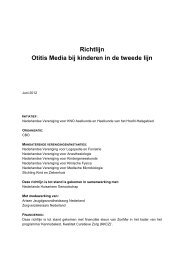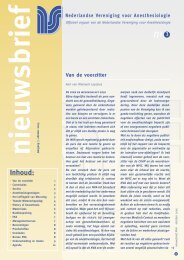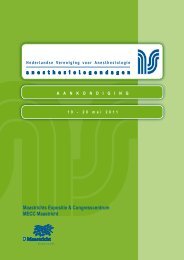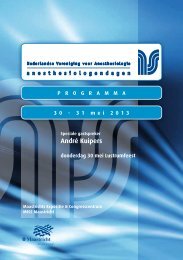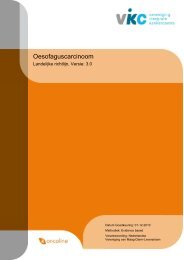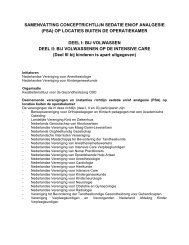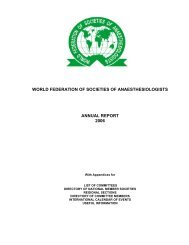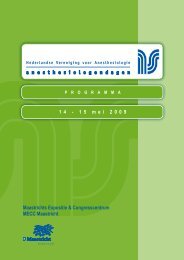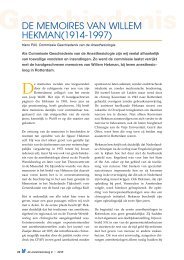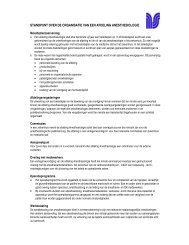programma - Nederlandse Vereniging voor Anesthesiologie
programma - Nederlandse Vereniging voor Anesthesiologie
programma - Nederlandse Vereniging voor Anesthesiologie
You also want an ePaper? Increase the reach of your titles
YUMPU automatically turns print PDFs into web optimized ePapers that Google loves.
GASTSPREKER<br />
Basic and Clinical Science in Neuromuscular Block<br />
Lars I Eriksson, MD, PhD, FRCA<br />
Professor and Academic Chair<br />
Dept of Anesthesiology and Intensive Care Medicine,<br />
Karolinska Institutet and Karolinska University Hospital,<br />
Stockholm Sweden<br />
Neuromuscular blocking agents (NMBAs) are widely used in anesthetic<br />
practice and occasionally in patients within intensive care. The molecular<br />
target for this class of agents are the nicotinic acetylcholine receptor<br />
(nAChR), widely spread with the central and peripheral nervous systems. This family of<br />
nicotinic cholinergic receptors consists of several subtype receptors, each having a typical<br />
structural conformation and subsequent function within neuromuscular transmission<br />
(muscle type nAChR) or neuronal control (neuronal subtype nAChRs). The nAChR is a<br />
membrane-bound and ligand-gated ion channel that operate over a wide range of synapses<br />
involved in critical control of vital functions.<br />
Non-depolarizing NMBAs interact with all subtype nAChRs, hereby producing a classical<br />
neuromuscular block with subsequent muscle paralysis and in addition an array of interactions<br />
with regulatory control of vital functions with significant clinical relevance. The<br />
interaction with muscle type nAChRs and neuronal subtypes nAChRs by non-depolarizing<br />
NMBAs (but not depolarizing NMBA) give rise to impaired neuromuscular transmission<br />
and typical changes in neurochemical transmission of action potentials over the synaptic<br />
cleft. This lead to typical electrical (EMG) and mechanical response patterns underlying<br />
the routine neuromuscular monitoring devices clinicians apply in daily clinical practice.<br />
The relationship between NMBA dose and neuromuscular blocking effect (sensitivity)<br />
varies considerably between different muscle groups, with muscles involved in pharyngeal<br />
control and airway integrity being the most sensitive among the vital muscle<br />
groups. In addition, the affinity of NMBAs to neuronal nAChRs lead to distinct changes in<br />
neurotransmission within the wakefulness and regulation of breathing, and in particular<br />
oxygen sensing and signaling systems involved in regulation of breathing during hypoxia.<br />
Residual effects of NMBAs therefore target vital control of ventilation in such as way<br />
that patient with residual neuromuscular block after extubation may encounter airway<br />
obstruction, aspiration and impaired ventilatory response to acute hypoxia.<br />
This lecture will provide basic molecular and cellular understanding of neuromuscular<br />
transmission and other relevant areas of neurotransmission, and furthermore the<br />
mechanisms by which neuromuscular blocking agents target regulatory control of vital<br />
functions of clinical relevance for anesthesia and intensive care.



